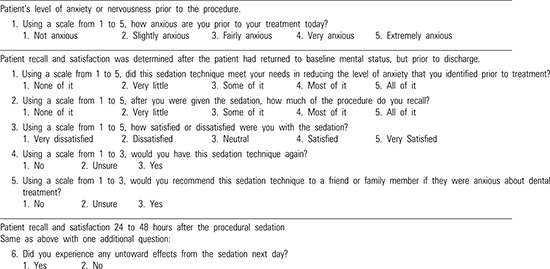Intravenous (IV) Sedation Protocols - IV Drug Administration for Moderate (Conscious) Sedation in Dentistry
Midazolam-First Administration – Titration to Effect (Moderate Sedation)
Midazolam and Fentanyl sedation protocol
Start sedation with midazolam
1. Draw 10 mg midazolam up to 10 ml with saline (1 mg/ml solution).
2. Administer 1–2 mg initially IV then 1 mg at 1 min intervals until the patient is suitably relaxed, and at sedation end-point of moderate sedation.
Start analgesia with fentanyl
3. Draw 50 mcg fentanyl up to 10 ml with saline (5 mcg/ml solution).
4. Administer 1 ml/min to a suitable end-point of 25–50 mcg. Level of fentanyl is based on procedure stimulus – practitioner judgement. For more complex procedures or surgery (e.g., surgical extraction - impacted wisdom teeth removal or extractions requiring bone removal and/or tooth sectioning), the full 50 mcg is generally administered, less complex cases (e.g., restorations, root canal therapy, crown and bridge treatment, dental cleanings, patients with a high gag reflex that required sedation and routine periodontal treatment) generally require 25 mcg or less.
5. Continuously assess the patient and monitor SpO2 levels.
6. Once the patient seems more relaxed, and at a suitable sedation end-point, then commence with local anesthetic administration.
Start anesthesia with local anesthetic administration
1. Wait for local anesthetic to take effect and then proceed with dental procedure
TITRATION OF SEDATION DURING PROCEDURE
1. IV sedation is generally adequate for procedures of 30–45 min. duration
2. If the procedure extends beyond this time frame and the sedation becomes inadequate then maintenance or supplemental titration may be required.
Wait 2 min. after administering supplemental midazolam before administering either midazolam or fentanyl.
Wait 2 min. after administering supplemental fentanyl before administering either fentanyl or midazolam.
Titrate in 1.0 ml increments.
IF THE PATIENT COMPLAINS OF1
Pain: assess the local anesthesia and re-administer
Discomfort: increase the fentanyl for analgesia
Awareness: increase the midazolam for sedation
REASONS TO STOP SEDATION OR SUPPORT PATIENT
If the patient becomes unresponsive and has entered a deeper level of sedation or general anesthesia then assess, support and observe the patient. Consideration must be given to administer antagonist or reversal agents: naloxone to reverse fentanyl, or flumazenil to reverse midazolam.
Fentanyl-First Administration – Titration to Effect (Moderate Sedation)
Fentanyl and Midazolam sedation protocol
Start analgesia with fentanyl
1. Draw 50 mcg fentanyl up to 10 ml with saline, (5 mcg/ml solution).
2. Administer 1 ml/min to a suitable end-point of 25–50 mcg. Level of fentanyl is based on procedure stimulus – practitioner judgement. For more complex procedures or surgery (e.g., surgical extraction - impacted wisdom teeth removal or extractions requiring bone removal and/or tooth sectioning), the full 50 mcg is generally administered, less complex cases (e.g., restorations, root canal therapy, crown and bridge treatment, dental cleanings, patients with a high gag reflex that required sedation and routine periodontal treatment) generally require 25 mcg or less. In fentanyl first administration, patients often mention they feel something, however there is not a definitive endpoint like is seen with midazolam administration.
3. Wait 2 min. after administering last increment of fentanyl before administering midazolam - continuously assess the patient and monitor SpO2 levels.
Start sedation with midazolam
4. Draw 10 mg midazolam up to 10 ml with saline, (1 mg/ml solution).
5. Administer 1–2 mg initially IV then 1 mg at 1-min. intervals until the patient is suitably relaxed, and at sedation end-point of moderate sedation.
6. Once the patient seems more relaxed, and at a suitable sedation end-point, then commence with local anesthetic administration.
Start anesthesia with local anesthetic administration
1. Wait for local anesthetic to take effect and then proceed with dental procedure.
TITRATION OF SEDATION DURING PROCEDURE
1. IV sedation is generally adequate for procedures of 30–45 min. duration.
2. If the procedure extends beyond this time frame and the sedation becomes inadequate then maintenance or supplemental titration may be required.
Wait 2 min. after administering supplemental midazolam before administering either midazolam or fentanyl.
Wait 2 min. after administering supplemental fentanyl before administering either fentanyl or midazolam.
Titrate in 1.0 ml increments.
IF THE PATIENT COMPLAINS OF1
Pain - assess the local anesthesia and re-administer
Discomfort – increase the fentanyl for analgesia
Awareness – increase the midazolam for sedation
REASONS TO STOP SEDATION OR SUPPORT PATIENT
If the patient becomes unresponsive and has entered a deeper level of sedation or general anesthesia then assess, support and observe the patient. Consideration must be given to administer antagonist or reversal agents: naloxone to reverse fentanyl, or flumazenil to reverse midazolam.








 PDF
PDF ePub
ePub Citation
Citation Print
Print






 XML Download
XML Download